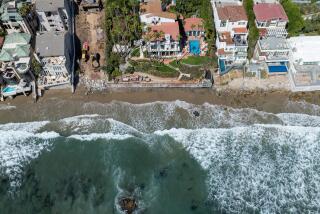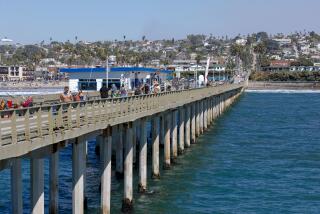Sands of Time Running Out for Battered Barrier Island
- Share via
ASSATEAGUE ISLAND, Md. — This narrow sliver of land is the first line of defense against the ruthless ambitions of the Atlantic, but the ocean is not respecting the line. Waves crash menacingly and retreat, carrying fistfuls of sand.
Maryland’s only undeveloped barrier island is washing away, as much as 15 feet a year in some stretches of shoreline. Its beaches and dunes, home to a unique mix of shore plants and birds, are being devoured, and scientists say the island is increasingly vulnerable to disintegration.
A storm could carve a hole in the skinny strip of land that buffers the mainland, exposing communities on the now-placid waters of Sinepuxent Bay to the unencumbered wrath of the Atlantic. A steady progression of waves could then batter shorefront homes and marinas. The tide could drive sand through the new opening and into the bay, which would require intensive dredging to remain navigable.
All that separates this 30-mile-long island from the rambunctious enclave of Ocean City is the quick crossing of an inlet, but the gap is greater than just space. Miles of boardwalk and high-rise hotels crowd Ocean City; Assateague has none of that. The island is a haven for beach-goers who like their peace, a place for bird-watching and nature walks amid a tribe of wild horses.
The National Park Service is working with the U.S. Army Corps of Engineers to replenish the shoreline with more sand, but plans have run into a thicket of bureaucracy.
The Corps’ Baltimore District office wants to erect a low berm of sand on the most vulnerable section of the island, a badly eroded 5 1/2-mile stretch of beach near the northern tip. That can be done for about $17 million, the Corps says. But headquarters in Washington will not allow work to begin until it settles on a long-term comprehensive plan, and that likely won’t happen until year’s end.
Meanwhile, the Atlantic hammers away.
Park Service officials worry that while government offices trade memos, a storm could descend and rip a new channel through the island, triggering its disintegration.
“You can’t predict when a storm is going to come,” said Carl Zimmerman, a National Park Service resource-management specialist. “It could be next week; it could be next decade. But we can say with some authority that the island is extremely vulnerable.”
More to Read
Sign up for Essential California
The most important California stories and recommendations in your inbox every morning.
You may occasionally receive promotional content from the Los Angeles Times.










